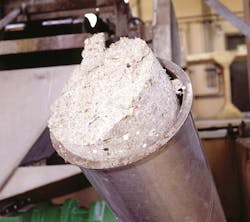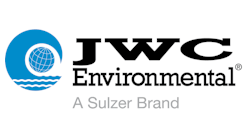The city of Oconto is a picturesque town in the northeastern corner of Wisconsin just outside the bustling city of Green Bay. It is situated on the Oconto River and serves as gateway to the fishing, boating and hiking regions in the Northwoods of Wisconsin. Unfortunately for Onconto, there was a problem in its corner of paradise.
After five years in operation, an old automated filter screen at the Oconto Wastewater Treatment Plant was wearing out. Several of its lifting teeth had broken off and it was letting rags pass, leading to problems downstream.
Managers at the Wisconsin facility faced another problem: foul odors. The heaping piles of fecal matter, rags and sticks the screen pulled from the channel were creating an unhealthy and obnoxious odor in the headworks building—the same place where operators had their offices.
Time for a Plan
With his bar/filter screen becoming toothless and useless, plant operator Steve Woodworth knew it was time to take action. He started designing a new headworks system for the 3.2-million-gal-per-day facility with a focus on reliable screening performance that would keep rags out of the rest of the plant. Equally important, for his own sake, was addressing the odor problems caused by the screens. After a rigorous analysis of screens, Woodworth selected the Monster separation system from JWC Environmental.
“We wanted to eliminate the mess of the old bar screen,” Woodworth said. “It was really bad—piles of fecal material, rags and sticks all sitting in the discharge trough, really gross. The compactor would get so overwhelmed at times, it wasn’t dewatering; it was just pushing stuff along.”
The separation system brought together a high-flow fine screen—in this case a center-flow Bandscreen Monster—and a heavy-duty washer-compactor called the Screenings Washer Monster.
The complete system captures and cleans unwanted wastewater solids, producing a dry, compact cake with no visible fecal matter; moreover, the reduction in odor was a relief for Woodworth and his crew.
Stopping the Stink
“We were introduced to the Screenings Washer Monster at a trade show, and we saw the cleanliness of the system,” Woodworth said. “We had a two-week onsite demonstration, and after I brought the commissioners out to take a look, we were approved to purchase one.”
Prior to installing the system, the Oconto operators were removing a 50-gal drum of smelly screenings twice a day, but they now empty the disposal drum about once a month, according to Woodworth. The screened debris also lacks the odors that used to waft through Woodworth’s office. The key to reducing the discharge by more than 90% is the system’s process: wash, grind, wash, compact and dewater.
The Screenings Washer Monster has an integrated 40K Muffin Monster grinder that preconditions the solids before washing. The grinder breaks open clumps of rags, plastics and trash to promote more effective washing. Nearly all the fecal matter is liquefied during washing and returned into the plant flow, where it belongs. Preconditioned screenings also dewater and compact much better, reducing the volume of screenings that must be hauled away.
Catching it All
Oconto’s new Bandscreen Monster is a traveling fine screen with an inside-out or center-flow pattern. Wastewater enters the screen and flows through the left or right sides of the screen through the moving panels. The panels, with 1/4-in. perforated openings, lift solids and unwanted material out of the flow and to deck level, where a series of deluge spray nozzles flushes the material into the Screenings Washer Monster. Because solids only touch the inside of the screenings band, there is no chance of carryover or bypass.
In general, a perforated plate fine screen is more effective in debris removal than a vertical bar screen. A perforated-plate screen will screen in two directions, meaning any debris larger than the size of the hole will be captured. Vertical bars, even very closely spaced bars, will only screen in one direction, allowing items such as wipes, cotton swabs, plastics and latex to pass through sideways.
“This is definitely an improvement and a really great system; we don’t see that mess anymore,” Woodworth said. “Before, we had to watch the bar screen and compactor constantly; now we don’t need to worry about it daily. I’d almost say we can forget about it.”
Total Plant Improvement
An improvement in downstream processes is another benefit for the Oconto plant operators, since the Bandscreen Monster removes many of the troublesome solids at the headworks. The flow sampler would frequently clog with rags prior to the installation of JWC’s fine screen, but now the plugging problem has disappeared.
Oconto’s wastewater treatment staff helps keep their corner of paradise clean and healthy, while the Monster Separation System is helping to keep the facility’s treatment process safe and trouble-free.



